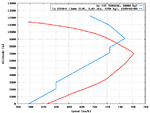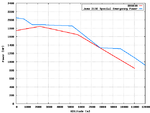davparlr
Senior Master Sergeant
No doubt that the D0-335 was the cleanest of all two engine designs (except possibly one with a counterrotating prop, but I don't know any designs that uses that combination. Several single engine planes tried it, but it was complex).Hi Davparlr,
>
The aerodynamical advantage of the Do 335 is evident from the height differential for roughly equal top speed since at low altitude, it is handicapped by the greater drag of the denser air. If you look at speed over altitude diagrams of WW2 fighters, speed invariably increases with altitude until the full through height of the engine is reached. (Since many engines had two supercharger speeds, they had two full-throttle heights, giving the familiar "sawtooth" look of so many curves.)
In short, if you provide the Do 335 with an engine of equal power but greater full throttle height that matches those of the fighters it's compared against, it will be faster than it was at 21000 ft, where it was as fast in terms of true airspeed as the others at 25000 ft.
I just have no idea of the thrust profile of the engine. Also, It would have been nice to have a SL top speed.
All I can say is that I have calculated it carefully, and don't mean it to be the final word on the type anyway. I just thought quoting an actual figure I personally consider realistic would be better than simply writing "It would have been very, very fast"
No doubt about this. It should have been very fast.


